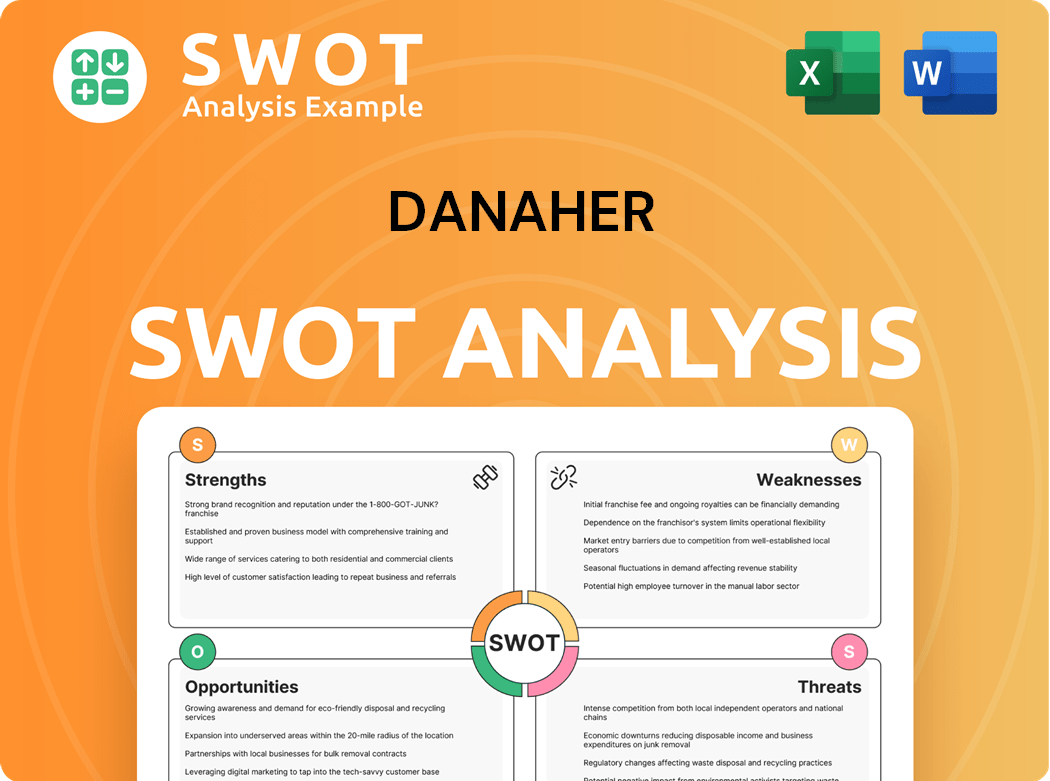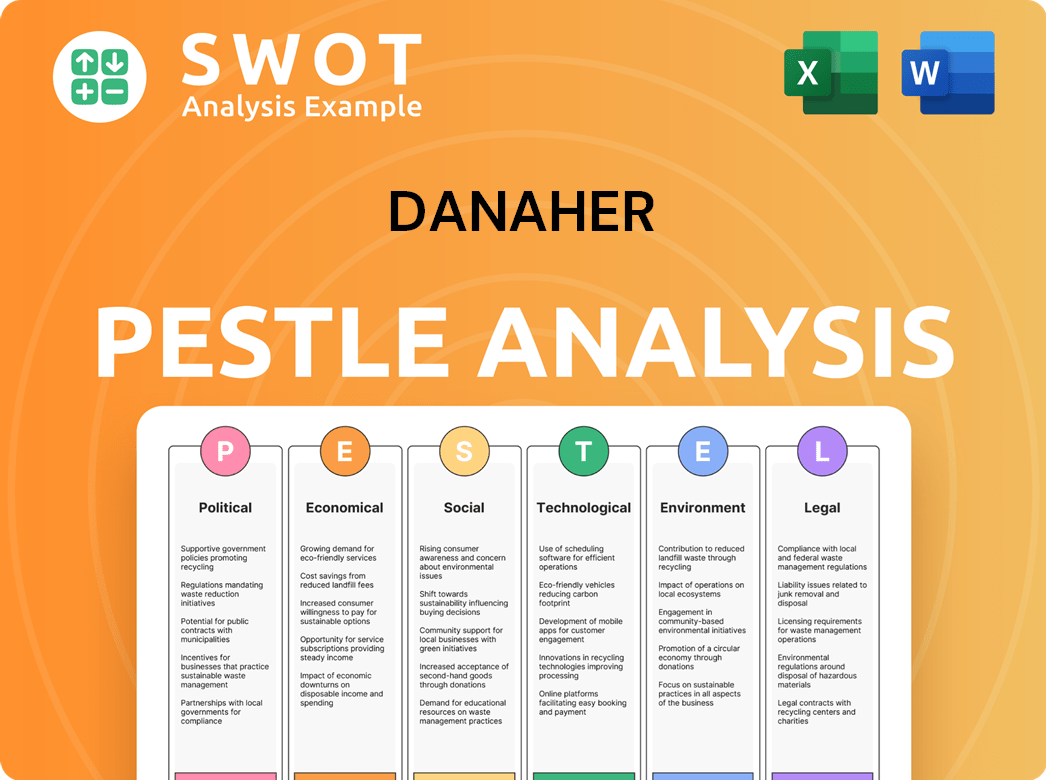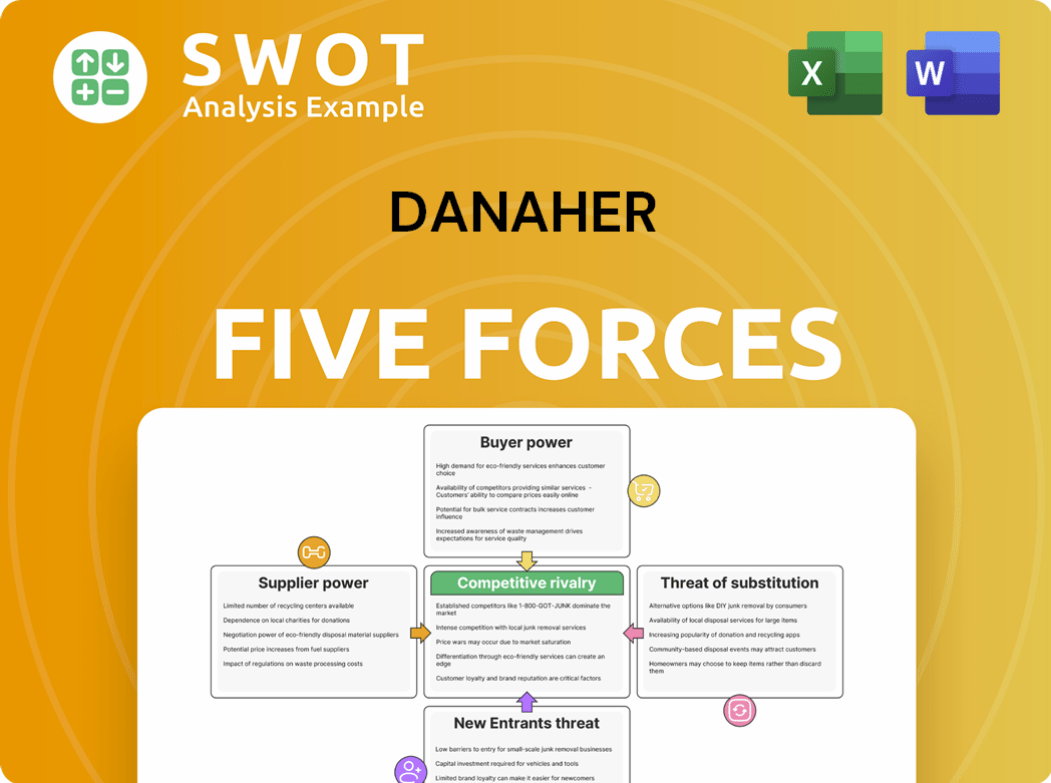Danaher Bundle
Who Really Controls Danaher?
Ever wondered who's truly steering the ship at Danaher Corporation, a global leader in science and technology? Understanding the Danaher SWOT Analysis is crucial, but knowing its ownership structure is even more fundamental. From its humble beginnings to its current $180 billion market capitalization, Danaher's journey is a masterclass in strategic evolution. This article pulls back the curtain on the key players shaping Danaher's future.

The Danaher company profile is a fascinating case study in corporate governance and strategic alignment. Knowing who owns Danaher is vital for investors looking to understand the forces driving its financial performance and strategic decisions. This deep dive into
Who Founded Danaher?
The story of Danaher Corporation, a significant player in the global market, began in 1984. The company was founded by brothers Steven M. Rales and Mitchell P. Rales, who set out to build a unique business model. Their vision centered on acquiring and improving manufacturing businesses, a strategy that would define Danaher's trajectory.
The Rales brothers implemented the Danaher Business System (DBS), a continuous improvement methodology. This system played a crucial role in shaping Danaher's early growth and ownership structure. The initial ownership structure was primarily held by the Rales family. However, the company's evolution involved public offerings, which broadened the investor base.
While the specific equity splits at the company's inception are not publicly detailed, the Rales family has maintained a significant ownership stake and considerable influence throughout Danaher's history. This control allowed for the consistent implementation of their operational strategies, contributing to the company's success. The founders' long-term commitment and strategic use of the DBS were instrumental in Danaher's early development.
Danaher Corporation, initially founded by Steven M. Rales and Mitchell P. Rales, saw its ownership evolve from a closely held structure to include a broader investor base through public offerings. The Rales brothers' influence was paramount, guiding the company's strategic direction and operational improvements. Their commitment to the Danaher Business System (DBS) was a key factor in the company's growth. Understanding the Growth Strategy of Danaher provides further insights into how the company has evolved.
- The Rales family's initial ownership was significant, though specific equity details are not publicly available.
- Public listings expanded the investor base, yet the founders maintained considerable influence.
- The Danaher Business System (DBS) was crucial for driving operational improvements and growth.
- The founders' long-term vision and strategic implementation of the DBS were key to early success.
Danaher SWOT Analysis
- Complete SWOT Breakdown
- Fully Customizable
- Editable in Excel & Word
- Professional Formatting
- Investor-Ready Format

How Has Danaher’s Ownership Changed Over Time?
The evolution of the ownership structure of the Danaher Corporation has been marked by significant shifts since it became a publicly traded entity. Initially, the ownership was concentrated, but over time, it has broadened to include a substantial presence of institutional investors. This transformation reflects the growth and maturation of the company within the market.
Key events have significantly impacted the ownership structure of the company. Strategic acquisitions and spin-offs have played a crucial role in reshaping the shareholder base. The separation of Fortive Corporation in 2016 and Veralto Corporation in 2023 are notable examples. These spin-offs redistributed ownership among existing shareholders and created new publicly traded entities, further diversifying the shareholder base.
| Shareholder | Shares Held (as of December 31, 2023) | Percentage of Ownership |
|---|---|---|
| The Vanguard Group, Inc. | Not specified | 8.94% |
| BlackRock, Inc. | Not specified | 8.08% |
| State Street Corp | Not specified | 4.22% |
As of early 2024, institutional ownership accounts for over 80% of Danaher's shares. Major institutional holders include prominent asset management firms like The Vanguard Group, BlackRock, and State Street Global Advisors. These firms manage substantial portfolios on behalf of their clients, making them significant stakeholders with considerable influence through their voting power. The Rales family, through various trusts and entities, continues to hold a substantial stake, demonstrating their enduring influence on the company's strategic direction. While their percentage ownership has diluted over time due to public offerings and acquisitions, their founding legacy and ongoing involvement remain a key aspect of Danaher's ownership profile.
Institutional investors hold a majority of Danaher's shares, with major firms like Vanguard and BlackRock as key stakeholders. The Rales family maintains a significant influence, reflecting their founding role. Strategic actions, such as spin-offs, have reshaped the shareholder base.
- Institutional ownership exceeds 80%.
- The Vanguard Group and BlackRock are major shareholders.
- The Rales family retains a substantial stake.
- Spin-offs have diversified the shareholder base.
Danaher PESTLE Analysis
- Covers All 6 PESTLE Categories
- No Research Needed – Save Hours of Work
- Built by Experts, Trusted by Consultants
- Instant Download, Ready to Use
- 100% Editable, Fully Customizable

Who Sits on Danaher’s Board?
The Board of Directors at Danaher Corporation, a key aspect of understanding Who owns Danaher, is responsible for overseeing the company's strategic direction and ensuring good governance. As of early 2024, the board includes a mix of independent directors and members with ties to significant ownership. Steven M. Rales and Mitchell P. Rales, continue to serve on the board, maintaining their influence. The board's composition reflects a diverse set of professionals with backgrounds in science, technology, and business.
Understanding the composition of the board is crucial for investors and stakeholders interested in Danaher ownership. The board's structure and the distribution of voting power are critical for corporate accountability. The board's role is to ensure that the company operates in the best interests of its shareholders, which is essential for maintaining investor confidence and driving long-term value. The board's decisions have a direct impact on Danaher company performance and its ability to navigate the complexities of the global market.
| Board Member | Title | Affiliation |
|---|---|---|
| Rales, Steven M. | Director | Danaher Corporation |
| Rales, Mitchell P. | Director | Danaher Corporation |
| Thomas P. Joyce, Jr. | President and CEO | Danaher Corporation |
| Other Independent Directors | Various | Various |
Danaher operates under a one-share-one-vote structure, meaning each common share generally entitles its holder to one vote. Major institutional investors, such as Vanguard and BlackRock, significantly influence the company through their substantial shareholdings. These investors engage with management and the board on governance matters. For those interested in Danaher stock and its performance, understanding the board's influence and the voting structure is essential for making informed investment decisions. For more insights, you can also explore the Marketing Strategy of Danaher.
The Board of Directors at Danaher includes both independent directors and members with significant ownership ties.
- The Rales brothers continue to influence the board.
- Danaher operates under a one-share-one-vote structure.
- Major institutional investors hold significant influence.
- Board composition is key for corporate accountability.
Danaher Business Model Canvas
- Complete 9-Block Business Model Canvas
- Effortlessly Communicate Your Business Strategy
- Investor-Ready BMC Format
- 100% Editable and Customizable
- Clear and Structured Layout

What Recent Changes Have Shaped Danaher’s Ownership Landscape?
In the past few years, Danaher Corporation has strategically refined its ownership structure. A key development was the spin-off of Veralto Corporation in late 2023. This move allowed Danaher to concentrate on its core life sciences and diagnostics businesses. The spin-off redistributed ownership to existing Danaher shareholders, creating two independent, publicly traded companies. This type of strategic move often causes temporary shifts in the shareholder base as investors adjust their portfolios.
The influence of institutional investors continues to shape Danaher's ownership profile. Large asset managers are increasingly focused on environmental, social, and governance (ESG) factors, which can affect their investment decisions. While there haven't been major founder departures recently, the gradual dilution of founding family ownership is a natural progression for mature public companies. Danaher's strategy focuses on organic growth, strategic acquisitions, and disciplined capital allocation, all influenced by its institutional and public ownership.
Danaher's ownership structure is primarily influenced by institutional investors. These investors often prioritize ESG factors, impacting investment decisions. The spin-off of Veralto in 2023 streamlined Danaher's focus on life sciences and diagnostics. This strategic move reflects ongoing adjustments in the company's ownership profile.
The spin-off of Veralto was a significant event, redistributing ownership among existing shareholders. Danaher's management has not announced major ownership changes beyond its normal course. The company's focus remains on organic growth and strategic acquisitions within its core segments. The company's stock symbol is DHR.
Danaher Porter's Five Forces Analysis
- Covers All 5 Competitive Forces in Detail
- Structured for Consultants, Students, and Founders
- 100% Editable in Microsoft Word & Excel
- Instant Digital Download – Use Immediately
- Compatible with Mac & PC – Fully Unlocked

Related Blogs
- What are Mission Vision & Core Values of Danaher Company?
- What is Competitive Landscape of Danaher Company?
- What is Growth Strategy and Future Prospects of Danaher Company?
- How Does Danaher Company Work?
- What is Sales and Marketing Strategy of Danaher Company?
- What is Brief History of Danaher Company?
- What is Customer Demographics and Target Market of Danaher Company?
Disclaimer
All information, articles, and product details provided on this website are for general informational and educational purposes only. We do not claim any ownership over, nor do we intend to infringe upon, any trademarks, copyrights, logos, brand names, or other intellectual property mentioned or depicted on this site. Such intellectual property remains the property of its respective owners, and any references here are made solely for identification or informational purposes, without implying any affiliation, endorsement, or partnership.
We make no representations or warranties, express or implied, regarding the accuracy, completeness, or suitability of any content or products presented. Nothing on this website should be construed as legal, tax, investment, financial, medical, or other professional advice. In addition, no part of this site—including articles or product references—constitutes a solicitation, recommendation, endorsement, advertisement, or offer to buy or sell any securities, franchises, or other financial instruments, particularly in jurisdictions where such activity would be unlawful.
All content is of a general nature and may not address the specific circumstances of any individual or entity. It is not a substitute for professional advice or services. Any actions you take based on the information provided here are strictly at your own risk. You accept full responsibility for any decisions or outcomes arising from your use of this website and agree to release us from any liability in connection with your use of, or reliance upon, the content or products found herein.